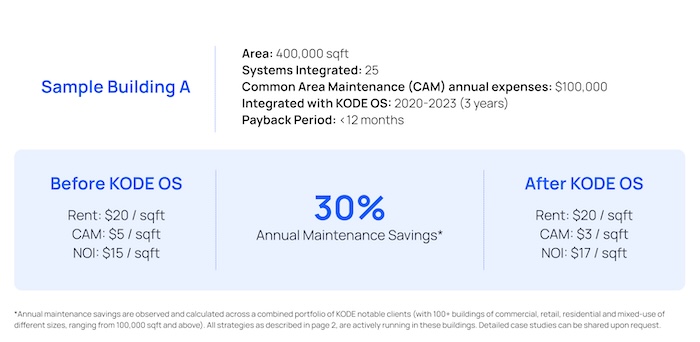Smart Buildings: Why investing in upgrades pays off
As energy costs rise and climate mandates tighten, building owners face mounting pressure to cut energy use and carbon emissions. With buildings accounting for about 30 percent of global energy demand, even small improvements can have a major impact.
Across commercial real estate, smart building upgrades are no longer just a trend, they’re a strategic priority. According to a 2024 World Economic Forum and PwC report, applying available energy-saving measures across buildings, industry, and transportation by 2030 could shrink global energy demand by up to 31 percent and save $2 trillion. Buildings alone could reduce their energy intensity by as much as 38 percent through proven steps that don’t require breakthrough new technology.

The tools are here. The challenge is putting them to work.
Why this shift is happening
Three forces are driving this change:
● Better technology. Sensors, cloud platforms, and AI controls get more advanced and reliable every year.
● Market pressure. Tenants and investors expect modern, energy-efficient spaces. Research shows green buildings can sell for up to 31 percent more and command up to 16 percent higher rents.
- Regulations. Laws like New York City’s Local Law 97 penalize inefficient buildings that exceed emissions caps.
In short, smart upgrades have moved from “nice-to-have” to “need-to-have.”
How Smart Systems Save Energy … and Money
Smart buildings slash waste by automating systems such as heating, cooling, and lighting. For example, using AI-powered software, HVAC systems can cut energy use by up to 25 percent. Smart lighting can reduce energy use by 40 percent to 90 percent.
Predictive maintenance extends equipment life and cuts emergency repairs. Our clients, for instance, have seen up to 20 percent lower maintenance costs and added years of life to building assets through proactive care.
When these upgrades work together on a single smart platform, the savings multiply. Platforms like ours connect all systems into one operating system that tracks real-time conditions and automates responses. Data on occupancy and indoor air quality can automatically adjust HVAC or lighting, cutting energy use by up to 30 percent. Owners get clear insights to fix problems before they become expensive.
 Strong ROI for owners
Strong ROI for owners
Smart upgrades don’t just pay for themselves; they boost income and value.
One study found that occupancy sensors and automation can cut room-level energy use by 22 percent, with an average payback period of two years. Smart HVAC and lighting upgrades often pay for themselves in two to three years.
The benefits go beyond lower utility bills. Energy-efficient buildings tend to sell for more, rent faster, and stay fully leased. Upgraded systems reduce the risk of unexpected breakdowns, lower insurance costs, and help meet new regulations. Some owners have cut operating costs by 30 percent while raising property values.
Tenants also want healthy, efficient spaces. Smart air quality controls, better comfort, and quick response times make people happier and more likely to stay. A smart building isn’t just a building; it’s a market advantage.
Staying ahead of regulations
Smart systems also help owners stay compliant with carbon rules. Take Empire State Realty Trust: it uses our operating system to track energy and emissions at iconic properties like the Empire State Building, meeting New York’s Local Law 97 requirements and avoiding fines.
Today’s clean energy and emissions rules demand real-time monitoring and efficient operations. Smart platforms make that possible and help buildings earn certifications like LEED and ENERGY STAR.
The high cost of doing nothing
Failing to upgrade carries big risks. Owners who delay smart upgrades may face:
- Higher energy bills as prices climb.
- Fines for exceeding emissions caps.
- Lost tenants and longer vacancies.
- More breakdowns and surprise repair costs.
- Lower property values as market standards rise.
In a tech-forward market, standing still means falling behind.
Getting started
Many owners know they need to act, but don’t know where to begin. A good first step is a building system audit to find waste and quick wins. Once systems connect on a single platform, savings often follow fast.
We see it daily: owners who link systems, gather data, and act see immediate payoffs, from lower costs to happier tenants.
Smart moves, real returns
Upgrading to smart building technology is no longer just about future-proofing. It’s a practical investment with measurable returns: lower energy costs, fewer breakdowns, higher tenant satisfaction, and easier compliance.
For commercial real estate owners, the choice is clear. Smart buildings work smarter, for your bottom line, your tenants, and the planet.
 Saruf Alam is Head of Mission Control (Smart Building Projects) at KODE Labs, a SaaS company providing KODE OS— a cloud-based smart building operating system that integrates both data and operational controls from various systems (like BMS, lighting, HVAC, IoT devices, etc.) into a single platform, enabling real-time visualization, analytics, and automation. With over six years at KODE Labs, Saruf leads the planning and execution of IoT and smart building deployments, helping clients transform complex real estate portfolios into data-driven, efficient, and scalable operations. He specializes in turning technical solutions into practical outcomes, delivering measurable performance and sustainability across the built environment.
Saruf Alam is Head of Mission Control (Smart Building Projects) at KODE Labs, a SaaS company providing KODE OS— a cloud-based smart building operating system that integrates both data and operational controls from various systems (like BMS, lighting, HVAC, IoT devices, etc.) into a single platform, enabling real-time visualization, analytics, and automation. With over six years at KODE Labs, Saruf leads the planning and execution of IoT and smart building deployments, helping clients transform complex real estate portfolios into data-driven, efficient, and scalable operations. He specializes in turning technical solutions into practical outcomes, delivering measurable performance and sustainability across the built environment.
KODE Labs | kodelabs.com
Author: Saruf Alam







